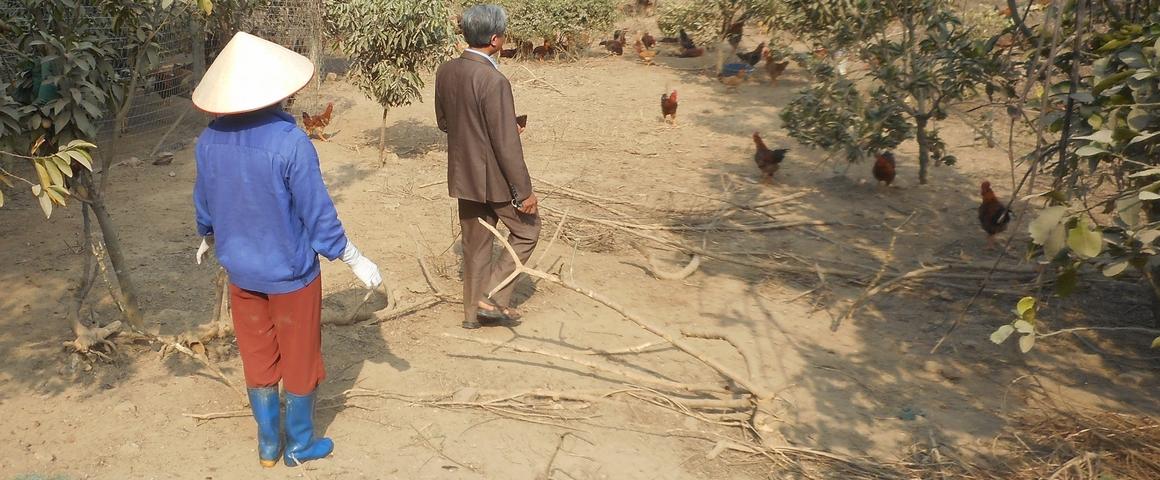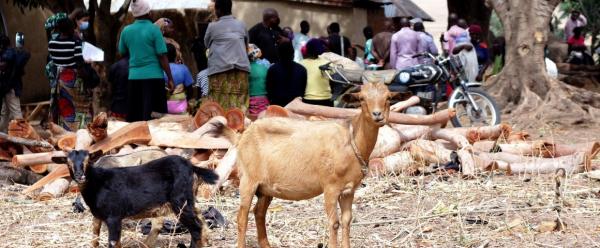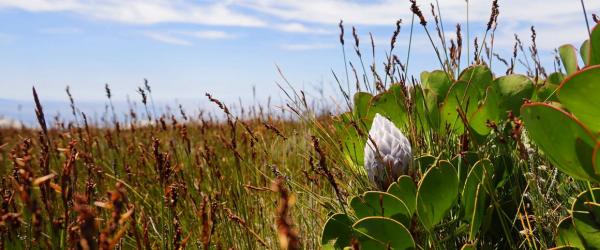Results & impact 28 October 2025
- Home
- CIRAD news
- News
- Local initiatives to counter antimicrobial resistance
Cutting antimicrobial use | What if farmers held the solutions?

In a municipality in northern Vietnam, poultry farmers have cut their use of antimicrobials by using probiotic-based alternatives © C. Bâtie, CIRAD
In 2015, Europe recorded 33 000 deaths linked to antimicrobial (antibiotic) resistance, according to the European Centre for Disease Prevention and Control. This figure, which is rising, reflects the development of resistance to drugs in bacteria.
Chloé Bâtie is a veterinarian and epidemiologist working on strategies to reduce antimicrobial use on Vietnam's chicken farms, and recently co-signed an article published in Plos ONE. As she explains, "When we looked at farmers' practices, we saw that many are testing ways of reducing antimicrobial use on a local level. We are now looking to find out why those local initiatives work, and how we can roll them out on a larger scale". She has conducted a qualitative study of 18 chicken farmers in northern Vietnam, ten of whom have already reduced their antimicrobial use.
This work fits into the framework of the ROADMAP project (see box), which set out to understand practices and opinions regarding antimicrobials on farms, analyse the socioeconomic factors governing their use, and pinpoint solutions for more rational use.
Obstacles to reducing antimicrobial use, despite the risks
In northern Vietnam, antimicrobials are used both to treat and to prevent disease, which fosters the development of resistance. "Most farmers have already heard of antimicrobial resistance, and some have seen it on their own farms", Chloé Bâtie says. "If they don't change how they work, it is often because they have no way of securing their production and profits."
Moreover, antimicrobial resistance develops quite slowly and almost silently. "Compared to infectious diseases, which have more immediate effects on both animals and humans, antimicrobial resistance develops over a much longer period", says CIRAD's Flavie Goutard, a veterinarian and epidemiologist. "Farmers do not see the effects for a few months or even years, when they realize that their usual antimicrobials do not work as well as they used to."
Economic pressure to keep production costs down, market fluctuations, a lack of suitable advice about drugs and of financial incentives, inadequate biosecurity measures, force of habit, and so on... despite the health risks, for both their animals and themselves, it is difficult for farmers to cut their antimicrobial use on their own. "It quickly becomes clear that the obstacles to change are not just the result of a lack of knowledge on the part of farmers", says Chloé Bâtie. "Farmers face what we might call "systemic" barriers, in other words barriers linked to the system into which chicken production fits. Individual initiatives exist, but they must be encouraged by means of a more general change involving the entire production chain."
Farmers are working together to move towards alternative methods
By working at grassroots level, with local communities, the scientists revealed changes on a local level. During their study, conducted jointly with several research organizations in Vietnam and France, Chloé Bâtie and Flavie Goutard questioned several farmers who had cut their antimicrobial use, notably by means of locally-produced probiotic-based alternatives, and who had set up a farmers' cooperative.
"The change began with a farmer who was aware of the issue, got the necessary training, and started to develop his own biotics", Chloé Bâtie explains. "A cooperative, backed by the government, grew up around the project, bringing together other farmers, veterinarians and drug vendors. The cooperative has allowed farmers to cut their costs, by pooling knowledge and resources and sharing the risks. It has also encouraged the dissemination of these solutions outside the community, and new outlets have been found to provide access to consumers in Hanoi."
Since a series of health scandals that rocked the country, Vietnamese consumers have become much more demanding in terms of quality. "One of the reasons quoted by farmers we questioned was the quality of the chicken produced, combined with reduced economic and social costs. This type of local initiative has proved popular in Vietnam, and consumers are keen to see the chicken they buy and know where it comes from. In the main urban centres, consumers are even prepared to pay a bit more for a safe product."
Upscaling: from local solutions to a widespread change in practice
As well as the above local initiatives, the researchers are above all hoping to highlight ways of perpetuating and disseminating such solutions. "Farmers are constantly innovating in order to overcome their day-to-day constraints. What we're interested in is understanding why and how some innovations manage to be rolled out beyond an individual level." For Flavie Goutard, this work in Vietnam shows the importance of bringing communities on board: "They are the ones who come up with their own solutions, which they tailor to their requirements and which are therefore effective. What we need to do now is to find more generally applicable methods to roll out these solutions. For instance, it could mean co-construction workshops during which participants from different sectors and levels could talk to policymakers, to suggest more appropriate public policies."
The CIRAD study led on to shared local workshops with farmers, drug and chicken vendors, a pharmaceuticals company, and also the local authorities (town, district and provincial vets). The results were then forwarded to national policymakers in Hanoi and national and international research centres.
"Commitment stems from simple things", Chloé Bâtie thinks. "Frequent meetings with farmers and reporting on solutions and debates encourages the participation and commitment of everyone involved. As scientists, we also have a role to play as the architects of these shared discussion spaces."
This project, based in nine European countries plus Mozambique and Vietnam, is working to understand how antimicrobials are used in livestock production systems and to promote a transition to rational antimicrobial use. The habits of livestock farmers, veterinarians, drug manufacturers, health authorities and others are under close scrutiny, with a view to imagining how that might be achieved, in the eventual aim of limiting the risks of the development of antimicrobial resistance phenomena. ROADMAP has 6 million euros of funding from the EU H2020 programme.
Transdisciplinary and participatory approaches are being used. The ROADMAP project was also built with the "One Health" concept in mind, as defined by the One Health High-Level Expert Panel (OHHLEP). This approach takes account of the links between animal, human and ecosystem health and associates a range of sectors and disciplines, to promote sustainable development and safeguard health.
ROADMAP project website: http://www.roadmap-h2020.eu/
Reference
Chloé Bâtie, Hang Tran Minh, Van Anh Thi Vu, Duong Thuy Luong, Trang Thi Pham, Nicolas Fortané, Phuc Pham Duc, Flavie Luce Goutard. 2023. Reducing antimicrobial use in chicken production in Vietnam: Exploring the systemic dimension of change. Plos One
https://doi.org/10.1371/journal.pone.0290296



























